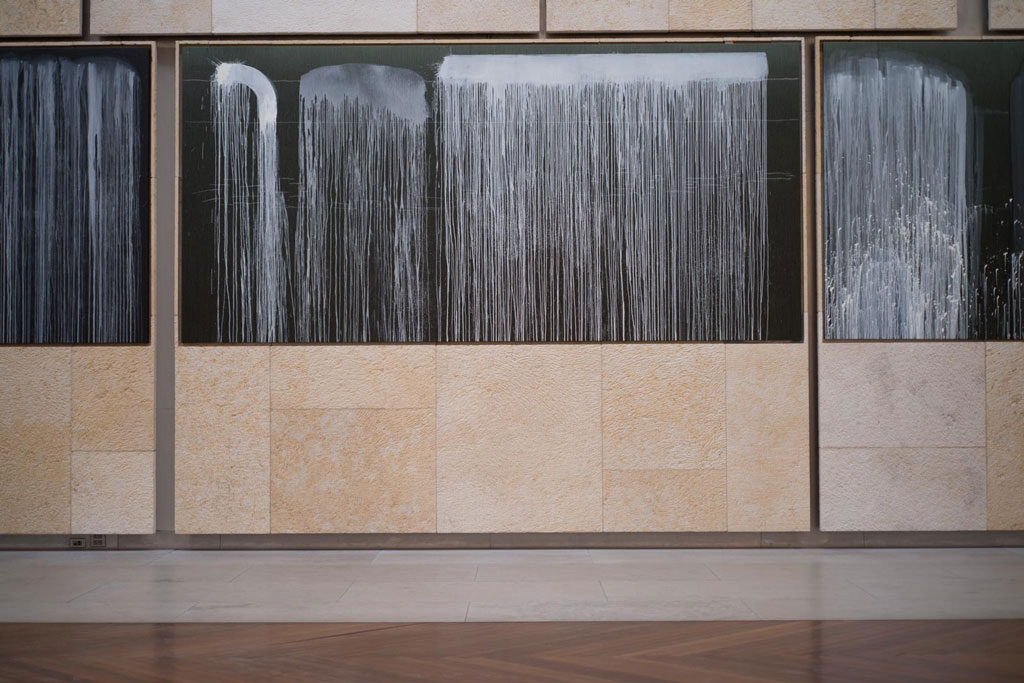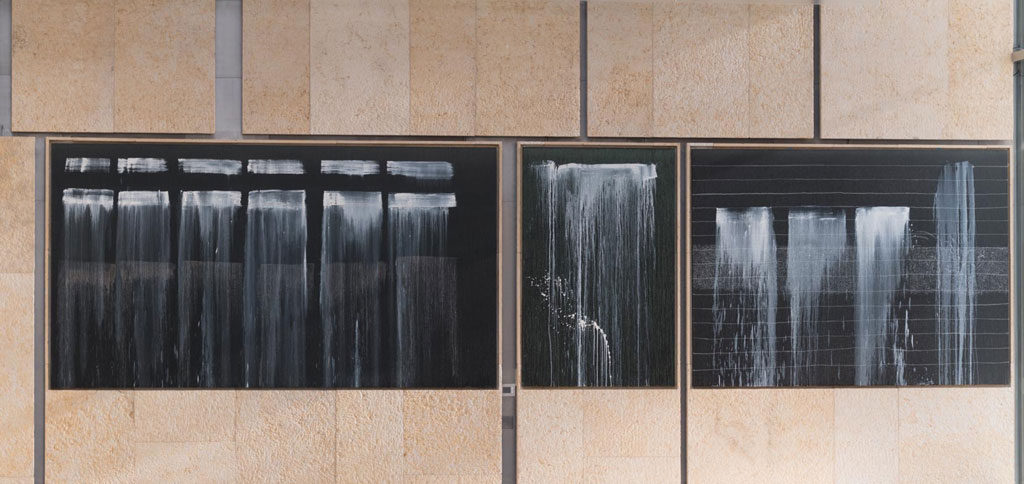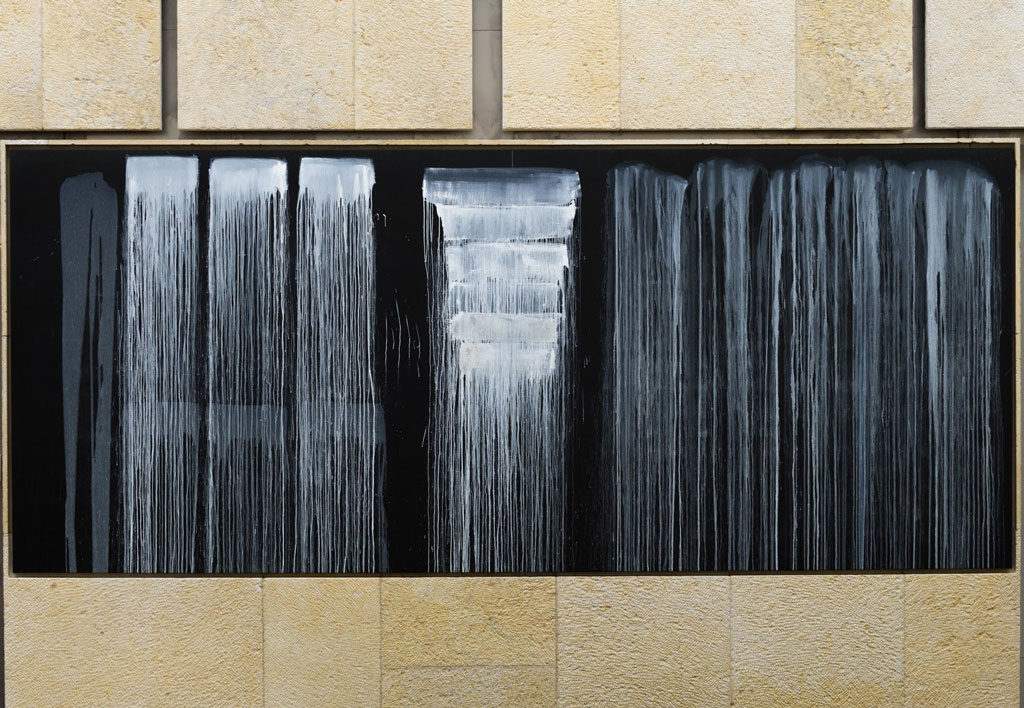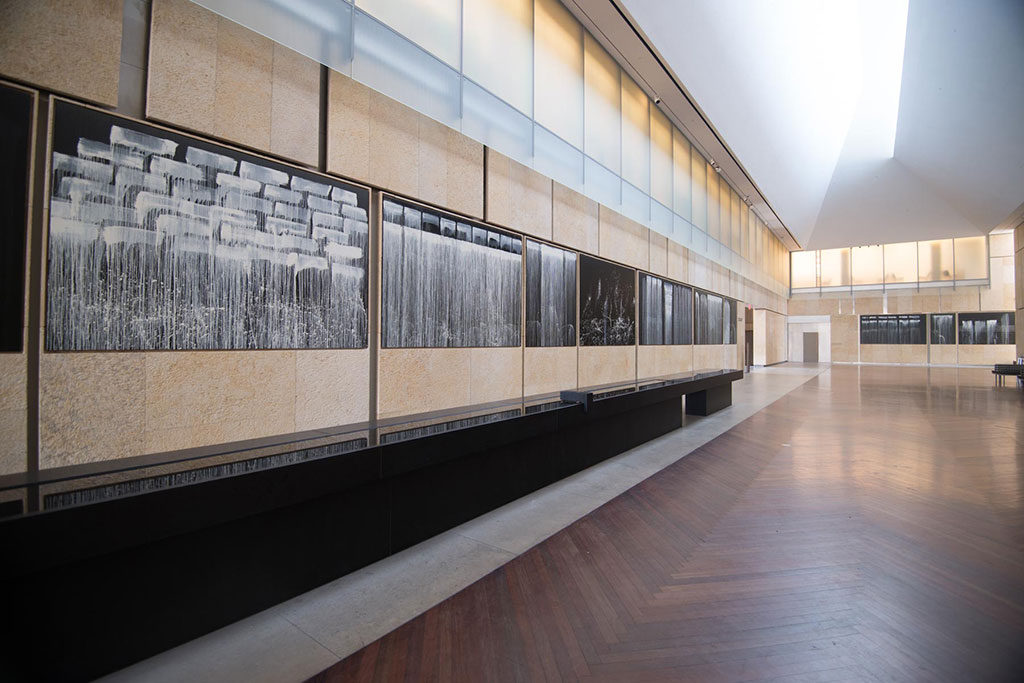Today’s artists, curators, and critics often assert that works of art themselves actively explore elements of human society, trouble conventional wisdom, demand that their audience consider specific issues, or otherwise directly affect their viewers and the world around them. I suspect that art objects are not really capable of such forceful agency, but even if they were, the paintings in the eleven-canvas Silent Secret Waterfalls: The Barnes Series by Pat Steir (NA 2006) would have little need for it. Each painting in the series, commissioned by the Barnes Foundation in Philadelphia and on view through November 17, appears content to simply live a life of its own.
Steir began to paint in her lauded “waterfall” style in the late 1980s, and since then her work has been defined by restraint. In Veronica Gonzalez Peña’s insightful documentary Pat Steir: Artist, the painter says that her idea was and has been to “let the paint itself make a picture.” Steir selects the colors of paint and the size of canvas that she will work with, and decides what manner of pouring or flinging she will use to combine these materials, but she rarely touches the surface of her pictures or paints on them in the traditional sense. This approach may at first sound like Jackson Pollock’s but, crucially, while Pollock laid his canvases on the floor so as to neutralize the effects of gravity and retain greater control, Steir tacks hers to the wall and allows paint to flow in uncontrolled and unpredictable ways. Hence the characteristic “waterfall” appearance—Steir’s paintings resemble natural phenomena because she allows liquidity and gravity to take over. While Pollock’s “action painting” was bodily and emotionally expressive, Steir speaks of her abiding desire “to take my ego out of the art, and my body out of the art.”

In stepping back and literally allowing her paintings to form themselves, Steir grants them agency in a real, rather than patronizing or wishful, way. As she told Gonzalez Peña, they give a great deal back in return: “I want the paintings to express something in the will of nature, like an equation in a way, strangely. Like when a physicist looks for what makes the universe hang together. I was looking in color and paint for what makes the universe hang together… It sounds so grandiose and insane, but it’s a spiritual quest.”
Steir’s ambitions may sound farfetched to some, but even the most cynical visitor to the Barnes will have to admit that the Silent Secret Waterfalls reward any earnest attention paid to them. They draw viewers in close with fine detail. Some feature tiny green lines that are nearly invisible from afar yet create a faint and gentle gradient as they peter out across the canvas from top to bottom. Others have black-on-black drips that are only perceptible when reflected light glistens off them at a favorable angle. One can even trace the path of each individual drip that moved inexorably downward but, almost impulsively, zigged and zagged along the way. And in the paintings’ larger compositional features, one can see a brewing pictorial contest between free-flowing liquids and Steir’s more orderly gestures, which include rectangles stamped out in paint, parallel horizontal lines, and in one case a uniformly-hazy horizontal band of thin squiggles. The stakes seem high here: can fully liberated, streaming paint peacefully coexist with these more regularized human elements? Happily, Steir keeps these forces in balance and their potential conflict becomes a collaboration that leaves their respective irregularity and regularity in spirited contrast. The more time I spent considering how Steir’s partnership with her paint played out, the more I could sense the gradual advancing of her quest. At the very least, these paintings are attractively intricate, tactile, crisp, bright, and calm. At most, they demonstrate that seemingly disparate forces of human control and natural generative power can be reconciled (in visual terms and maybe more).

When I first went to see the Silent Secret Waterfalls in late February, they flanked the entrance to an exhibition titled From Today, Painting Is Dead: Early Photography in Britain and France. That show closed in May, but I still think it was wonderfully apt that contemporary paintings so full of movement and vitality stood present to refute the old concerns that inspired their neighbor’s title. Steir’s work shows that painting is still alive and lively, and indeed that the Barnes is too. Gallery labels and reviews have highlighted the fact that her series is the first site-specific installation at the Barnes Foundation since Henri Matisse started work on The Dance in 1930, but even this association with a canonical modernist undersells Steir’s achievement in these particular canvases.
Without completely rehashing the philosophical and legal vagaries of the institution’s well-covered history, it suffices to say that when Matisse painted The Dance, Albert Barnes still presided over a collection of then-current art (which already included ample representation of Matisse’s own work). Since that time, Barnes himself died and left his collection frozen in time, sealed away from touring or new additions and available to the public only on a limited basis. More recently, with a contested move from Philadelphia’s suburbs to a new building near the city’s center, the Foundation began to warm and thaw. So while Matisse and Steir each executed commissioned work for the same institution, they did so under drastically different circumstances.

Thom Collins, the Barnes’s current Executive Director and President, who aims to make the institution an accessible forum rather than a dusty resting place for grand narratives, personally organized the exhibition of Steir’s work. The series hangs in the Annenberg Court, the Barnes’s lobby which stands just off the Benjamin Franklin Parkway and (unlike the rest of the building) requires no admission to enter. Steir’s series is almost as quiet and serene as the title Silent Secret Waterfalls suggests, but her paintings nevertheless rise ably to this context. By extending and expanding the tradition of painting, Steir lends fresh openness and relates to the Barnes’s longstanding collection, and by trusting in paint itself, she fosters a spark of life in her work and in the institution that commissioned it.
Silent Secret Waterfalls: The Barnes Series is presented at the Barnes Foundation in Philadelphia January 12 – November 19, 2019.
Jeffrey Katzin is a doctoral candidate at the University of Pennsylvania, currently working on a dissertation project concerning the history and potential of abstract photography. He is particularly interested in abstract art and its capacities to convey political, philosophical, and personal meaning.

